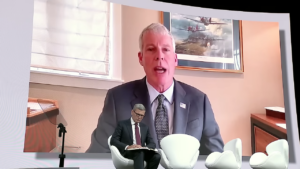Simon Hackett, the executive chair of battery storage maker Redflow, says the company’s first shipment of 10kWh zinc bromine “flow” batteries is en route to Australia, but that rolling them out to the market will be a slow process, but expressions of interest in the Australian made technology numbering in the thousands.
Speaking at the Disruption and the Energy Market conference hosted by RenewEconomy in Sydney on Tuesday, Hackett said that Redflow had received 1300 expressions of interest in the battery, known as the ZCell, since launching its residential website roughly a month ago.

“The first of the batteries in the nice sexy cases is on the water now,” Hackett told the conference, ”But it’s going to be slow. Clearly it’s an early adopter thing right now, but that’s how technology works.
“We are just on the cusp, we think, of this making a real difference in the world,” he said.
Last Friday, the company gave similar figures in a release to the stock exchange.
“We have (to date) fielded direct expressions of interest in buying energy systems using our products from over 1,200 people around Australia. We have received enquiries from over 380 installers who are interested in creating solutions for customers based on the ZCell platform.”
Hackett told the conference that he personally trained 45 installers last week “because I know how it works” and more would be trained in coming months. Hackett has installed the technology in his home and his business premises. The company intend announcing its initial ZCell installation company list in mid September.
Hackett, whose pedigree is in IT and who confesses to being “attracted to interesting technology” (he’s owns multiple Tesla EVs), describes the ZCell as “actually, a really good battery.”
And while he clearly has a vested interest, he detailed a number of reasons why he thinks it has an advantage over other technologies and chemistries, namely lead-acid and lithium-ion.
Chief among these reasons is that it doesn’t lose capacity with age – Hackett says the flow batteries last 10 years, delivering “true 100 per cent depth of discharge daily energy cycles.
Another “cute characteristic”, he said, was that the flow batteries could be switched off for long periods (weeks, months) “and back on (much) later with no energy loss.”
Further, the batteries are made mostly of recyclable reusable parts, including mostly plastic casings and reusable electrolyte fluid – “quite unusually nifty for a battery,” says Hackett.”
On the safety side, the batteries actively “self-protect” from damage – from current, temperature, etc – by switching off, instead of melting down, meaning you “can’t break it by working it too hard.”
And unlike their lithium-ion counterparts they’re not a fire risk. Bromine, says Hackett, is a traditional fire extinguisher material, “so this battery will neither contribute to a fire nor accelerate one” – a notable plus for a technology most people will be putting in or on their homes.










